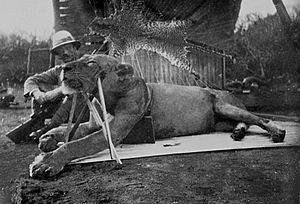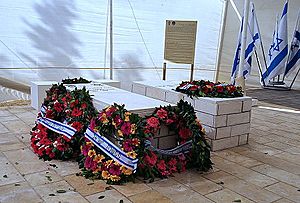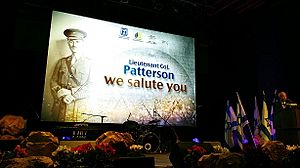John Henry Patterson (author) facts for kids
Quick facts for kids
John Henry Patterson
|
|
|---|---|
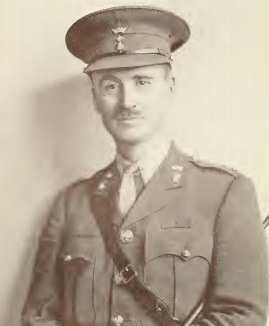 |
|
| Born | 10 November 1867 Forgney, County Longford |
| Died | 18 June 1947 (aged 79) Bel Air, California |
| Buried |
Avihayil, Israel
|
| Allegiance | |
| Branch | |
| Service years | 1884–1920 |
| Rank | Lieutenant-Colonel |
| Commands held | Jewish Legion |
| Wars | |
| Awards | Distinguished Service Order |
| Spouse(s) |
Frances Helena Gray
(m. 1895) |
| Children | Bryan Patterson |
Lieutenant-Colonel John Henry Patterson was an Anglo-Irish soldier, hunter, and writer. He is famous for his book The Man-eaters of Tsavo (1907). This book tells about his adventures building a railway bridge in Africa from 1898 to 1899. His story inspired three movies: Bwana Devil (1952), Killers of Kilimanjaro (1959), and The Ghost and the Darkness (1996). During World War I, Patterson led the British Army's Jewish Legion. Many people see this group as an early version of the Israel Defense Forces.
Who Was John Henry Patterson?
Early Life and Military Career
John Henry Patterson was born in 1867 in Forgney, County Longford, Ireland. His father was Protestant and his mother was Roman Catholic.
He joined the British Army when he was 17 years old in 1885. He became a Lieutenant-Colonel. He also received the Distinguished Service Order (DSO) for his bravery. He left the army in 1920.
Adventures in East Africa
In 1898, Patterson was asked to build a railway bridge. This bridge was over the Tsavo River in what is now Kenya. He arrived at the site in March of that year.
The Tsavo Man-Eaters
Soon after Patterson arrived, lion attacks began. Lions would drag workers from their tents at night. The workers were very scared. They built thorn fences and kept bonfires burning. But the attacks got worse.
The bridge building stopped because workers were too afraid to stay. Patterson had to deal with this big problem. Many workers believed the lions were evil spirits. They thought the attacks started because Patterson had arrived.
These man-eating lions were unusual. They were a pair of male lions. People believed they killed as many as 140 people. Railway records show 28 worker deaths. But many local people were also killed, and these deaths were not officially recorded.
Scientists have different ideas why the lions ate humans. One idea is that there were many unburied bodies from the slave trade in the area. Lions are scavengers, meaning they eat dead animals. They might have gotten used to eating human bodies. Another idea is that one lion had a bad tooth. This might have made it hard for him to hunt other animals.
Patterson was an experienced hunter. He had hunted tigers in India. He decided to stop the lions. After months of trying, he killed the first lion on December 9, 1898. He killed the second lion on December 29. He almost died when the wounded lion charged him.
The lions were very large. Each was over nine feet long from nose to tail. It took eight men to carry each lion back to camp.
The workers and local people saw Patterson as a hero. News of his bravery spread quickly. Even the Prime Minister, Lord Salisbury, mentioned it in the House of Lords.
With the lions gone, workers returned. The Tsavo railway bridge was finished on February 7, 1899. Patterson later wrote a book about his adventures. It was called The Man-Eaters of Tsavo.
In 1924, Patterson sold the lion skins and skulls to the Field Museum of Natural History in Chicago. They are still on display there today.
Discovering a New Eland
In 1906, Patterson went back to Tsavo for a hunting trip. He shot an eland, which is a type of large antelope. He noticed it looked different from other elands.
When he returned to England, a scientist named Richard Lydekker saw the eland's head. Lydekker realized it was a new type of eland. He named it Taurotragus oryx pattersonianius after Patterson.
Game Warden Role
Patterson was later made a Game Warden. This meant he was in charge of protecting animals in the East Africa Protectorate. He wrote about this experience in his second book, In the Grip of Nyika (1909).
War Service
Second Boer War
Patterson fought in the Second Boer War (1899–1902). He received the Distinguished Service Order again. He was appointed to command the 33rd Battalion, Imperial Yeomanry, in 1902. However, the war ended before his battalion arrived in South Africa.
Ulster Volunteer Force
Before World War I, Patterson commanded a group called the Ulster Volunteers. This group was formed in Ireland to prevent Home Rule. Many Ulster Protestants did not want to be governed by a parliament in Dublin.
In 1914, the Ulster Volunteers secretly brought 20,000 rifles and 2 million bullets into Ireland. Patterson is believed to have been part of this operation. The Home Rule Crisis stopped when World War I began.
World War I and the Jewish Legion
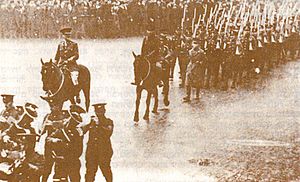
Patterson served in the First World War. Even though he was a Protestant, he became very important to Zionism. Zionism is the movement to create a Jewish homeland. He led two Jewish military groups: the Zion Mule Corps and the 38th Battalion of the Royal Fusiliers. This second group was also known as the Jewish Legion. These groups are seen as the beginning of the Israeli Defence Force.
The Zion Mule Corps fought bravely in the Gallipoli Campaign. It was the first Jewish fighting force in almost 2,000 years.
While leading the Jewish Legion, Patterson faced a lot of unfair treatment towards his men. Many of his superiors were against Jewish soldiers. Patterson often threatened to quit to make sure his men were treated fairly. He retired from the British Army in 1920. He gave up chances for promotion to stand up for his soldiers. He wrote two more books about these experiences: With the Zionists at Gallipoli (1916) and With the Judaeans in the Palestine Campaign (1922).
Supporting Zionism
After his military career, Patterson continued to support Zionism. He worked hard for justice for the Jewish people. He was part of groups that wanted to stop The Holocaust and create a Jewish army to fight the Nazis.
He was good friends with many Zionist leaders. One of them was Benzion Netanyahu. Benzion Netanyahu named his first son, Yonatan Netanyahu, after Patterson. Yonatan later became a hero in Israel.
Patterson worked hard for a separate Jewish state in the Middle East. This dream came true with the creation of Israel on May 14, 1948. This was less than a year after Patterson died.
Family Life
Patterson married Frances Helena Gray in 1895. She was one of the first women in the UK to earn a law degree. Their son, Bryan Patterson (1909–79), became a scientist who studied ancient life forms.
Later Life and Final Wish
In the 1940s, Patterson and his wife lived in California. As they got older and their health declined, they moved in with a friend. Patterson died in his sleep at age 79. His wife died six weeks later. They were both cremated.
Patterson's grandson said that one of his last wishes was to be buried in Israel. He wanted to be near the men he commanded in World War I. In 2010, efforts began to make this wish come true.
With help from the Israeli government, Patterson and his wife were re-buried in Israel on December 4, 2014. They were laid to rest in the Avihayil cemetery. Some of the men he led are buried there too.
The Prime Minister of Israel, Benjamin Netanyahu, attended the ceremony. He called Patterson "the godfather of the Israeli army." He also called him "a great friend of our people" and "a great believer in the Jewish State."
A special postal stamp was made in Patterson's honor by the Israel Philatelic Service.
Images for kids
See also
- Tsavo Man-Eaters
- W. D. M. Bell


